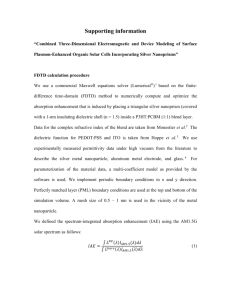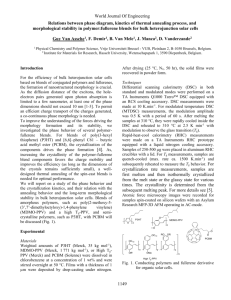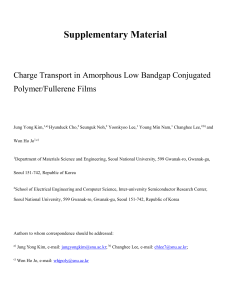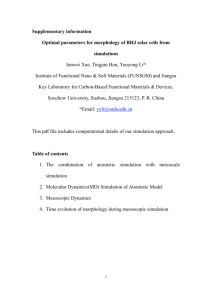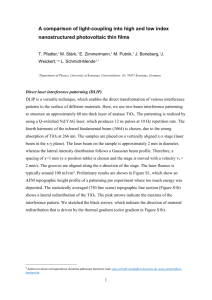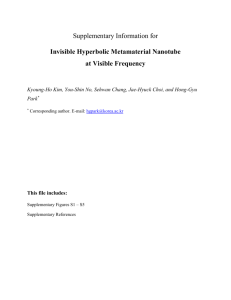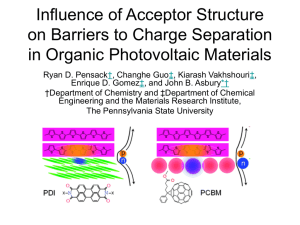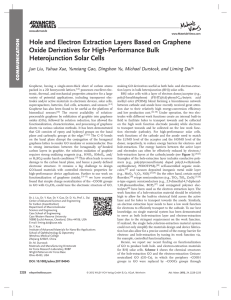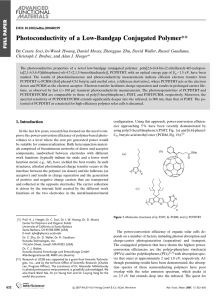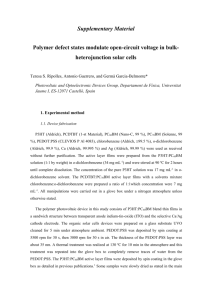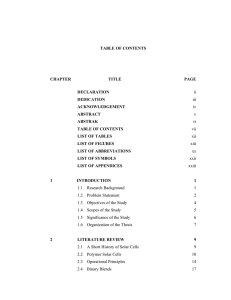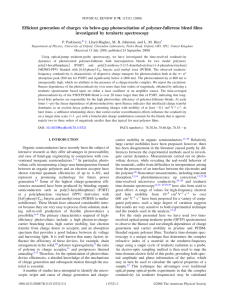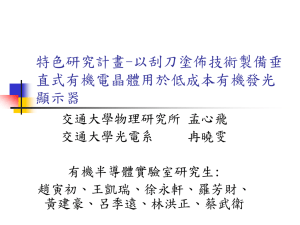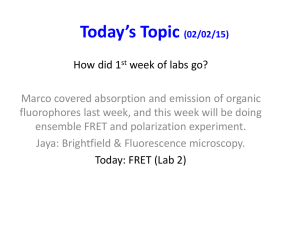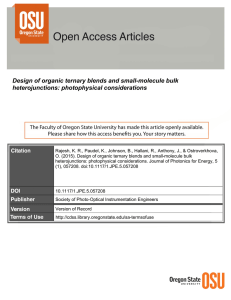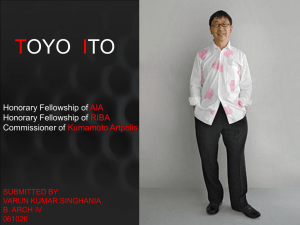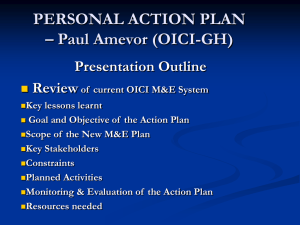PCBM P3HT
advertisement
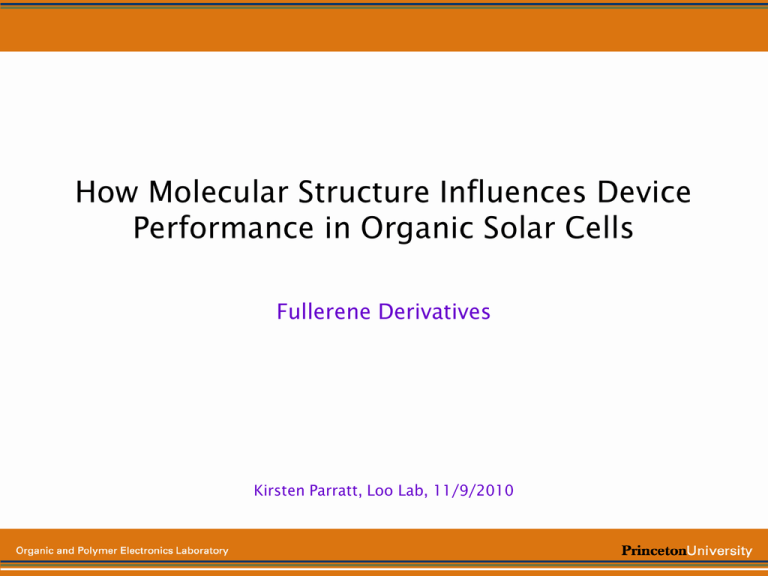
How Molecular Structure Influences Device Performance in Organic Solar Cells Fullerene Derivatives Kirsten Parratt, Loo Lab, 11/9/2010 How it works • Photons absorbed by the organic compounds in the active layer create an exciton which diffuses randomly • Upon reaching the acceptor and donor interface, the electron dissociates from the hole • Both electron and hole are transported to their respective electrode Al Al Al ITO ITO ITO Why Organic Solar Cells? An alternative to silicon solar cells: • Easier manufacturing • Low temperature processing • Solution processing • Lower costs • Flexible substrates Electron Acceptor and Donor • P3HT/PCBM cells currently have one of the highest efficiencies (~5-6%) • PCBM: [6,6]phenyl-C61-butyric acid methyl ester, acceptor small molecule • P3HT: Poly(3-hexylthiophene), donor polymer LUMO 3.7 eV Al P3HT P3HT PCBM ITO Al PCBM 5.1 eV ITO Light HOMO Electron Acceptor and Donor • P3HT/PCBM cells currently have one of the highest efficiencies (~5-6%) • PCBM: [6,6]phenyl-C61-butyric acid methyl ester, acceptor small molecule • P3HT: Poly(3-hexylthiophene), donor polymer Light • Charge transport through pi orbitals 3.7 eV Al P3HT ITO 5.1 eV PCBM P3HT PCBM Electron Acceptor and Donor • P3HT/PCBM cells currently have one of the highest efficiencies (~5-6%) • PCBM: [6,6]phenyl-C61-butyric acid methyl ester, acceptor small molecule • P3HT: Poly(3-hexylthiophene), donor polymer 3.7 eV Al P3HT ITO 5.1 eV PCBM P3HT PCBM Electron Acceptor and Donor • P3HT/PCBM cells currently have one of the highest efficiencies (~5-6%) • PCBM: [6,6]phenyl-C61-butyric acid methyl ester, acceptor small molecule • P3HT: Poly(3-hexylthiophene), donor polymer 3.7 eV P3HT ITO 5.1 eV PCBM P3HT PCBM Al Overview of Morphology-Length Scales Molecular ordering Crystal size Phase separation Structure/Function Relationship • Systematically altered fullerene for better packing • How the molecules pack effects device performance CF3-TNPS-Tet-Fu TNPS-Tet-Fu TES-Tet-Fu Large Small Side group Side group J. Anthony Desired Stacking Bad transfer Good transfer • Contact between fullerenes should have better charge transfer • Fullerene-acene contact will be worse • Best packing comes from the closest fullerenes J. Anthony Bad transfer Stacking Good transfer CF3-TNPS-Tet-Fu TNPS-Tet-Fu TES-Tet-Fu Good Bad Transport Transport J. Anthony Single Carrier Diodes • Composed of only a fullerene • No photocurrent generation • Measure the transport of charge through the active layer ITO Fullerene Pedot Al Mobility ue= (J0.5/V)2* L3*e0*er*8/9 e0-permitivity of free space = 8.85418782 × 10-12 m-3 kg-1 s4 A2 er-dielectric constant = 3.9 - Measure of how fast charges can transport through the layer [J (mA/cm^2)]^0.5 0.6 CF3-TNPS-Tet-Fu TNPS-Tet-Fu Tes-Tet-Fu 0.5 0.4 0.3 0.2 0.1 0.0 0 1 2 3 Voltage (V) 4 Efficiency Jsc 2.0 Efficiency = max power 100 mW/cm2 J (mA/cm^2) 1.6 1.2 0.8 Maximum power 0.4 0.0 -0.4 -0.75 Voc Bilayer -0.50 -0.25 0.00 Voltage (V) 0.25 Bilayer Comparison • Jsc shows same trend as mobilities in SCD • CF3-TNPS-Tet-Fu shows worst Jsc and device performance Efficiency (%) 0.24 0.18 J (mA/cm^2) 3.3E-2 CF3-TNPS-Tet-Fu TNPS-Tet-Fu Tes-Tet-Fu 0.12 1.6E-3 0.06 0.00 4.77E-5 -0.06 -0.9 -0.6 -0.3 0.0 Voltage (V) 0.3 Conclusion • The observed mobilities and efficiencies show the same trends • Most likely this trends correlates to the size of the side group CF3-TNPS-Tet-Fu TNPS-Tet-Fu TES-Tet-Fu Large Side group Small Side group Low efficiency High efficiency Future Work Crystallized derivatives would allow us to determine if the molecules are packing as planned – More through testing of solvent vapor and thermal annealling – Thermal evaporation of the fullerene layer Acknowledgements • • • • Professor Loo Stephanie Lee Loo lab PEI
